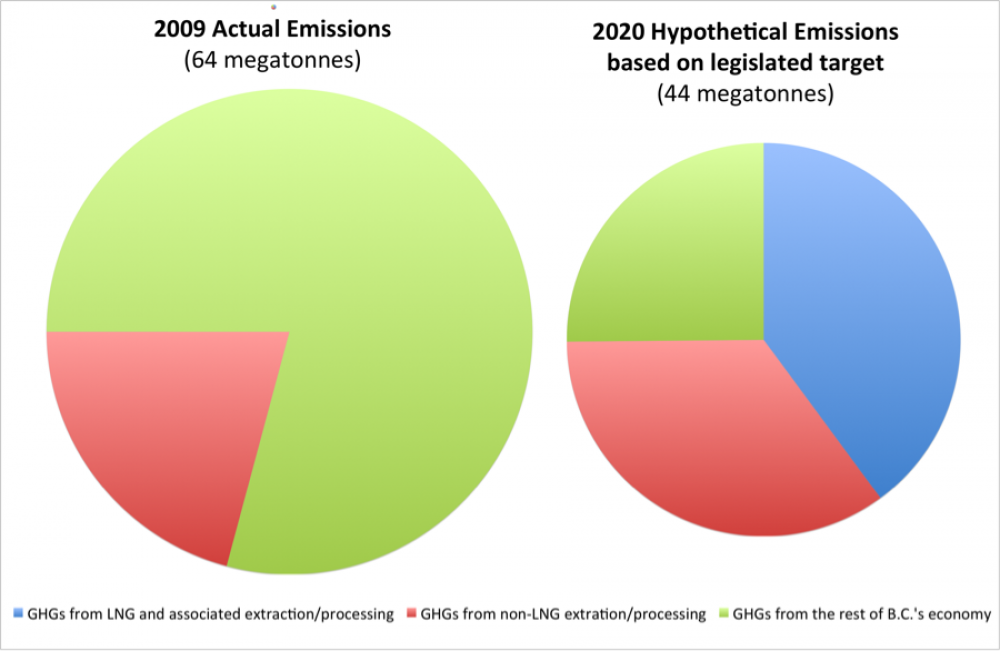British Columbia’s new liquefied natural gas (LNG) strategy is peppered with claims that it goes hand in hand with leadership on climate change. While demonstrating climate leadership by increasing fossil fuel extraction may seem like an oxymoron, there are scenarios in which the government could actually do both. Unfortunately, that isn’t the case this time.
The three LNG facilities proposed for construction in the next eight years would process as much gas as B.C. currently produces. This potential doubling comes with high environmental costs including greenhouse gas emissions produced by extracting, transporting and burning natural gas; water contamination during the process of hydraulic fracturing; and the fragmentation of caribou habitat from the construction of roads and pipelines.
Big emissions sources remain largely unaddressed
The GHGs produced by getting the natural gas out of the ground and transporting it to the LNG facilities are much higher than those from the facilities themselves. While the province discusses options such as electrification and carbon capture and storage that would limit those emissions, it does not commit to any new policies that would encourage or require them. Without those policy solutions in place, we can count on about 15 million tonnes of GHGs per year from supplying the three LNG facilities. That would gobble up 35 per cent of the GHG quota that B.C. has legislated for itself in 2020.
Expanding the scope to look at GHGs from the entire natural gas sector — not just the gas destined to become LNG — that 35 per cent doubles to 70 per cent. Not to mention that those numbers don’t account for some emerging research that indicates shale gas wells leak considerably more methane (a potent greenhouse gas) than previously estimated.
Small steps toward positive change
The province’s promise to power the first two LNG facilities with clean electricity would limit one source of GHGs and it is a standard that should be required for any new LNG plants. The third proposed LNG facility, which the province said could be powered by natural gas, is a good illustration of why.
If powered by natural gas, that third plant would release two million tonnes of GHGs per year. To put that in context, one single LNG facility would produce almost as much as one half of the 1.8 million homes in B.C. That would add another five per cent to the province’s 2020 GHG quota.
Adding up all of the emissions from natural gas extraction and processing, and the LNG facilities, B.C.’s natural gas sector stands to be responsible for 33 million tonnes of GHGs in 2020 — a whopping 75 per cent of the provincial quota.
Without implementing much stronger policies the provincial government will be leaving the rest of the B.C.’s businesses and communities with a small piece of the pie: only 11 million tonnes of the quota for the entire economy — an impossible cut of approximately 78 per cent from current levels in eight years.
Without addressing these glaring omissions in its LNG strategy, B.C.’s provincial climate targets will not be met.
Wishful thinking
B.C.’s LNG exports will primarily be burned to generate electricity, producing another 54 million tonnes of GHGs in the process. The provincial government claims those GHGs are good because they would be even higher if it was coal being burned instead. An equally plausible argument, however, is that LNG exports increase overall emissions because they replace lost or delayed nuclear capacity.
Until the jurisdictions that import B.C.’s LNG have stronger climate policies in place, any claim that fossil fuels will reduce GHG emissions should be viewed with a healthy dose of scepticism.
Setting the bar for a climate friendly natural gas strategy
The province’s current claims of climate leadership within its natural gas strategy are flawed, but filling the gaps can be straightforward.
First, all LNG facilities need to be powered by renewable electricity that is as low-impact as possible.
Second, government needs to implement policies that constrain the GHGs from extracting and processing natural gas. For example, the province should close a loophole in the carbon tax and require natural gas companies to pay for all of their emissions and continue to increase the tax (see recommendations one and three in this report).
Third, there needs to be a conversation about how much natural gas and LNG the province is going to produce. At one to three plants, the GHGs produced could be managed with strong policy. Beyond that, managing GHGs (not to mention other impacts) gets harder and harder if the projects keep stacking up.
Looking beyond B.C.’s borders, the province needs to advocate for effective climate policy in the jurisdictions that it is selling to, and could prioritize LNG export relationships to regions with such policies. The province could also apply the carbon tax to LNG exports until those types of policies are in place.
Without these necessary steps, the province cannot claim that its LNG plan supports climate leadership. Taking time to develop this non-renewable resource will allow the province to ensure they do it right from a climate change perspective. While that may require a more measured approach, it will mean B.C. is doing what it can to protect the planet’s climate and position its natural gas industry — and B.C.’s entire economy — to appropriately deal with evolving climate change policy.
Note: The estimates for GHGs in this blog are dependent on anticipated natural gas production levels and how GHG-intensive that development is expected to be. In most cases there is a range of plausible values because development plans are uncertain. The assumptions and calculations we used are based on earlier Pembina research and they are available here. The Canadian Centre for Policy Alternatives and the B.C. Sustainable Energy Association have also produced estimates and they are available here and here.










